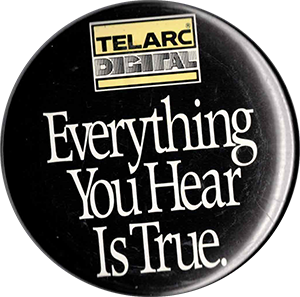The Office: Telarc Edition
In addition to the recording team of producers, engineers, and editors, many other Telarc employees played a vital role in getting a release into the hands of listeners. The production department included graphic designers, a project manager, and a contracts and royalties manager. The writing (and if needed, translation) of program notes was typically contracted out. Even before the recording was released, the sales and marketing department would get to work making sure that Telarc’s dealers knew it was coming. They would also send review copies and other information to the press, both general and specialized. When the disc arrived from the pressing plant, it was processed by Telarc’s own warehouse team, who handled distribution. Finally, there were the departments that are necessary to any properly-run business, such as accounting and human resources.
The Telarc employees were a close-knit bunch.1 There were annual gatherings in the summer and at the holidays, and casual conversations in the office hallways were encouraged. Telarc co-founder Bob Woods described the atmosphere in a newspaper profile: “We’ve got a lot of creative, artistic-minded people here. They not only see business from that angle, but life in general. And business well done, business functioning at its maximum potential, is an art.”2
Business well done, business functioning at its maximum potential, is an art.
Bob Woods, Telarc
In 2021 Telarc employees held a reunion gathering that included a slideshow describing where each one present has been since their time with the company and paying tribute to those who had passed away.3 Some of the attendees had maintained relationships with their co-workers for many years after they left the company. These close relationships were acknowledged in Mix Magazine’s tribute to engineer Michael Bishop, published two months after his death in 2021: “Mix asked a few members of the Telarc family—and they were a family—about their friend, Michael Bishop.”4
In addition to the listings of equipment used, the credits page of Telarc’s recordings contained mentions for the entire production team (click to view.) as well as other major contributors on each project.5 At the urging of producer and editor Erica Brenner and the other orchestral musicians on Telarc’s production team, Telarc later began listing the orchestra personnel in the booklet for select CDs on which they performed (click to view). Unfortunately this practice is still rare in the classical music business.
Credit for this productive and positive work environment goes to Telarc’s leadership. Bob Woods and Jack Renner’s first full-time employee was Elaine Martone, who later became VP in charge of much of the hiring. Together, they set the tone for working in Telarc’s fast-paced, creative space. In her interview with author Leslie Gaston-Bird for the book Women in Audio, Elaine put it this way:
The author is grateful to be a part of the Telarc family.7
Last updated on March 4th, 2025 at 03:52 pm
- An in-depth assessment of Telarc’s corporate culture was published in Joanne Drause Klein, “Orchestrating Success,” Corporate Cleveland, Vol. 5, Issue 3, March 1991. ↩︎
- Quoted in Klein, “Orchestrating Success.” ↩︎
- Concord/Telarc sales executive Kajo Paukert shared this slideshow with the author, January 2024. ↩︎
- “Michael Bishop Remembered,” Mix Magazine, May 18, 2021. ↩︎
- Many classical recordings list only the engineer(s) and producer(s), if even that. ↩︎
- Leslie Gaston-Bird, Women in Audio, Audio Engineering Society Presents (New York ; London: Routledge/Taylor & Francis Group, 2020), pp. 143-144 ↩︎
- From 1993-1997, I was an assistant engineer and editor with Telarc, and have remained friends with many of my colleagues since then. ↩︎
